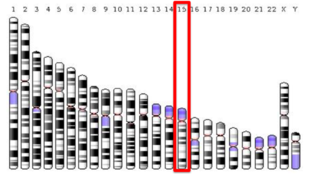
FAM83H is a protein, which in humans is encoded by the FAM83H gene. The protein is also known as uncharacterized protein FAM83H. FAM83H is targeted for the nucleus. It is predicted to play a role in the structural development and calcification of tooth enamel.

Coiled-coil domain 47 (CCDC47) is a gene located on human chromosome 17, specifically locus 17q23.3 which encodes for the protein CCDC47. The gene has several aliases including GK001 and MSTP041. The protein itself contains coiled-coil domains, the SEEEED superfamily, a domain of unknown function (DUF1682) and a transmembrane domain. The function of the protein is unknown, but it has been proposed that CCDC47 is involved in calcium ion homeostasis and the endoplasmic reticulum overload response.

Transmembrane protein 134 is a protein encoded by the TMEM134 gene. TMEM134 does not have any other known aliases. There are two transmembrane domains and a domain of unknown function (DUF872). Evolutionary, the majority of the organisms that have this gene are primates and mammals, although there are some organisms dating back to Drosophila and C. elegans. Through current research, there has not been any confirmed function of TMEM134.

Family with sequence similarity 63, member A is a protein that, is encoded by the FAM63A gene in humans,. It is located on the minus strand of chromosome 1 at locus 1q21.3.

C8orf48 is a protein that in humans is encoded by the C8orf48 gene. C8orf48 is a nuclear protein specifically predicted to be located in the nuclear lamina. C8orf48 has been found to interact with proteins that are involved in the regulation of various cellular responses like gene expression, protein secretion, cell proliferation, and inflammatory responses. This protein has been linked to breast cancer and papillary thyroid carcinoma.

GPATCH11 is a protein that in humans is encoded by the G-patch domain containing protein 11 gene. The gene has four transcript variants encoding two functional protein isoforms and is expressed in most human tissues. The protein has been found to interact with several other proteins, including two from a splicing pathway. In addition, GPATCH11 has orthologs in all taxa of the eukarya domain.

PRR29 is a protein encoded by the PRR29 gene located in humans on chromosome 17 at 17q23.

PROSER1 is a protein that in humans is encoded by the PROSER1 gene.
Coiled-coil domain containing protein 180 (CCDC180) is a protein that in humans is encoded by the CCDC180 gene. This protein is known to localize to the nucleus and is thought to be involved in regulation of transcription as are many proteins containing coiled-coil domains. As it is expressed most highly in the testes and is regulated by SRY and SOX transcription factors, it could be involved in sex determination.
Cardiac-enriched FHL2-interacting protein (CEFIP) is a protein encoded by the gene C10orf71 on chromosome 10 open reading frame 71. It is primarily understood that this gene is moderately expressed in muscle tissue and cardiac tissue.

C21orf62 is a protein that, in humans, is encoded by the C21orf62 gene. C21orf62 is found on human chromosome 21, and it is thought to be expressed in tissues of the brain and reproductive organs. Additionally, C21orf62 is highly expressed in ovarian surface epithelial cells during normal regulation, but is not expressed in cancerous ovarian surface epithelial cells.

Uncharacterized protein C12orf60 is a protein that in humans is encoded by the C12orf60 gene. The gene is also known as LOC144608 or MGC47869. The protein lacks transmembrane domains and helices, but it is rich in alpha-helices. It is predicted to localize in the nucleus.

CRACD-like protein. previously known as KIAA1211L is a protein that in humans is encoded by the CRACDL gene. It is highly expressed in the cerebral cortex of the brain. Furthermore, it is localized to the microtubules and the centrosomes and is subcellularly located in the nucleus. Finally, CRACDL is associated with certain mental disorders and various cancers.

Chromosome 8 open reading frame 58 is an uncharacterised protein that in humans is encoded by the C8orf58 gene. The protein is predicted to be localized in the nucleus.

Chromosome 21 Open Reading Frame 58 (C21orf58) is a protein that in humans is encoded by the C21orf58 gene.

C15orf39 is a protein that in humans is encoded by the Chromosome 15 open reading frame 15 (C15orf39) gene.

Chromosome 19 open reading frame 44 is a protein that in humans is encoded by the C19orf44 gene. C19orf44 is an uncharacterized protein with an unknown function in humans. C19orf44 is non-limiting implying that the protein exists in other species besides human. The protein contains one domain of unknown function (DUF) that is highly conserved throughout its orthologs. This protein is most highly expressed in the testis and ovary, but also has significant expression in the thyroid and parathyroid. Other names for this protein include: LOC84167.
Chromosome 1 open reading frame (C1orf167) is a protein which in humans is encoded by the C1orf167 gene. The NCBI accession number is NP_001010881. The protein is 1468 amino acids in length with a molecular weight of 162.42 kDa. The mRNA sequence was found to be 4689 base pairs in length.

Family with sequence 98, member C or FAM98C is a gene that encodes for FAM98C has two aliases FLJ44669 and hypothetical protein LOC147965. FAM98C has two paralogs in humans FAM98A and FAM98B. FAM98C can be characterized for being a Leucine-rich protein. The function of FAM98C is still not defined. FAM98C has orthologs in mammals, reptiles, and amphibians and has a distant orhtologs in Rhinatrema bivittatum and Nanorana parkeri.

KIAA2012 is a protein which, in humans, is encoded by the KIAA2012 gene. KIAA2012 is expressed at very low levels throughout the body, but it is primarily expressed in the ovary, lungs, and brain.















